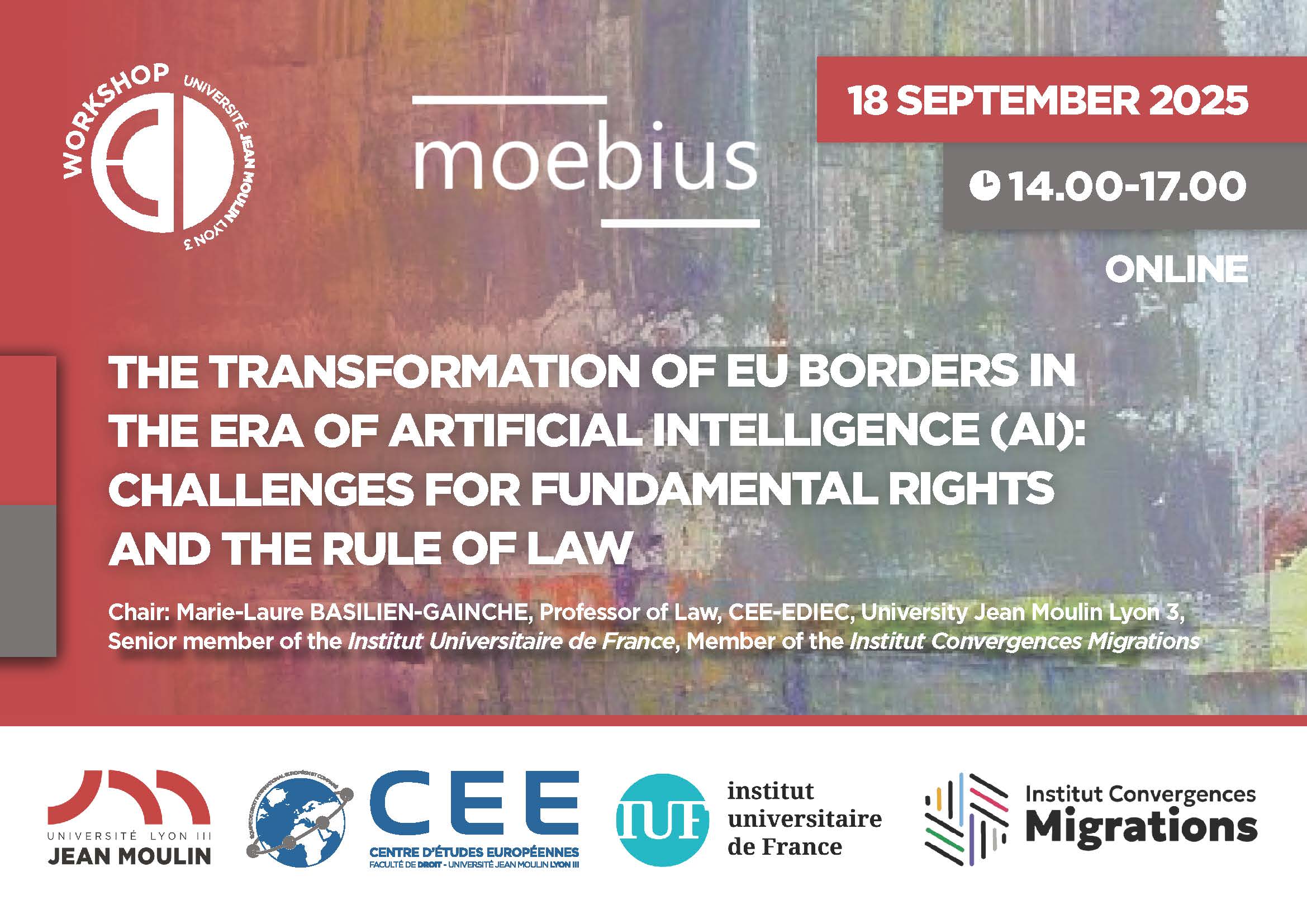- Droit,
- Informatique,
- Recherche,
Workshop MOEBIUS – The Transformation of EU Borders in the Era of Artificial Intelligence (AI): Challenges for Fundamental Rights and the Rule of Law

Chair: Marie-Laure BASILIEN-GAINCHE, Professor of Law, CEE-EDIEC, University Jean Moulin Lyon 3, Senior member of the Institut Universitaire de France, Member of the Institut Convergences Migrations
DISCUSSANT
Niovi VAVOULA, Assistant Professor, University of LuxembourgAbstract
Since the past few decades, the performance of EU border controls has significantly transformed through reliance on highly complex digital tools which rely on the collection and processing of large quantities of personal data of different groups of third-country nationals, as a means to control and manage the entry of migrants and refugees. The EU borders has become more and more smart: pixellised and filtering. This increased digitalisation has more recently given way to algorithmisation to make sense of the data collected and identify novel ways to exploit them through the use of Artificial Intelligence (AI) systems. Whereas emphasis at the policy making level has been largely focused on the benefits of AI in terms of promoting consistency in individual decision-making and enhancing administrative efficiency, the challenges for fundamental rights and the Rule of Law require closer attention. This panel aims to provide a holistic overview of the transformation of EU borders by the use of different AI tools, and highlight the issues posed particularly by algorithmic risk assessments and facial recognition technology for biometric identification for individuals. The existing protection offered under EU data protection law, as interpreted by the Court of Justice of the European Union (CJEU), as well as the AI Act, will be analysed to determine existing opportunities and gaps meriting further attention.- BORDER CONTROL IN AN AUTOMATED CONTEXT: LOOKING FOR NEW MODALITIES OF THE RULE OF LAW REQUIREMENTS
-
Amanda MUSCO EKLUND, Doctoral student, Department of Law, Umeå University, Sweden
Previous research has shown how the recent introduction of automated systems in border control – such as automated risk assessments under the PNR directive and EU IT-systems ETIAS and VIS – implies increased opacity for those seeking to cross EU borders. Contemporary technological developments and their implementation at borders puts into question the efficiency of traditional rule of law safeguards in preventing arbitrariness in this new automated context. The traditional understanding of the substantive legality requirement on the foreseeability of law stems from a time of solely human decision-making, which relies on the existence of rule of law safeguards established over time in a non-automated context. This understanding of the foreseeability requirement cannot be directly translated to the new context of automation. This paper analyses what constitutes a sufficient degree of foreseeability in the automated EU border control regime according to the Court of Justice of the European Union (CJEU) and the EU legislator. Generally, the paper aims to fill a gap in the understanding of the wider rule of law implications of automation in the context of automated border control by discussing (1) the institutionalisation of trust in statistical correlations and probability as a new underlying and unforeseeable logic for automated decision-making, and (2) how this logic cements the techno-solutionist assumption that we trust statistical correlations to represent reality and that they are capable of individual assessment. - FACIAL RECOGNITION AT EU’S BORDERS: HUMAN RIGHTS SAFEGUARDS FOR THIRD-COUNTRY NATIONALS AND THE IMPACT OF THE AI ACT
-
Evelin BROUWER, Senior-researcher and Lecturer, Law Faculty, Utrecht University - Montaigne Centre for Rule of Law and Administration of Justice
I will address the increasing use of facial recognition technologies (FRT) for the purpose of border and migration control in the European Union (EU). Focusing on law and practices concerning the storage of facial images in EU’s large-scale databases (SIS, Eurodac, VIS, EES, ETIAS and ECRIS-TCN), I will discuss the impact of FRT for the human rights of third-country nationals, and more specifically the right to private life and data protection. On the basis of relevant case-law by the ECHR and CJEU, necessary human rights safeguards will be identified. Finally, this presentation will explore the relevant rules in the AI Act and question their added value for the legal protection of third-country nationals. - ALGORITHMIC DECISION-MAKING IN MIGRATION AND SECURITY IN THE EU: CHALLENGES IN ENSURING EFFECTIVE LEGAL REMEDIES
-
Tamas MOLNAR, PhD of Law, EU Agency for Fundamental Rights, Legal Research Officer – Project Manager, Guest Researcher, WU Vienna University of Business and Economy, Institute for Law and Governance
Discussions have recently intensified at the European Union (EU) level on the potential use of AI-driven technology in the area of migration and security. Likewise, the new generation of large-scale EU IT systems will use algorithms to screen
third-country nationals against risk profiles. If carefully conceived, implemented and monitored, AI could bring substantial opportunities to improve the efficiency of the EU area of ‘freedom, security and justice’, while safeguarding and eventually
strengthening fundamental rights. Yet, there are also a wide range of fundamental rights risks which include questions about access to effective legal remedies in cases of AI supported decision-making. The right to an effective judicial remedy
(Article 47 of the EU Charter of Fundamental Rights) equally applies to decisions taken with the support of AI. Decision-making driven by AI can challenge this right of primary importance in various ways (e.g. accessing remedies becomes more
difficult against such decisions; rebutting the results of the algorithm is highly complicated; courts lack knowledge/expertise on how to provide effective remedy). After outlining the European legal framework applicable to the intersection of AI
and access to justice, this contribution zooms in on two case studies to illuminate the specific challenges the right to an effective remedy faces in the context of AI used for migration and law enforcement: 1) the European Travel Information and
Authorisation System (ETIAS) screening rules; and 2) algorithmic decision-making under the EU Passenger Name Records (PNR) Directive, notably in light of the CJEU ruling in Ligue des droits humains (C-817/19). - EUROPE’S TECHNO-BORDERS: PAST, PRESENT AND FUTURE
-
Chris JONES, Director of Statewatch
The digital technologies deployed as part of Europe’s techno-borders underpin invasions of privacy, brutal violations of human rights, and make the border ‘mobile’, for example through the increased use of biometric identification technologies, such as handheld fingerprint scanners. In a report published in July 2023, Statewatch examined the past, present, and near-future of the digital technologies deployed by the EU for border control and migration management purposes. This comprises an extensive infrastructure of surveillance systems, databases, biometric identification techniques and information networks has been put in place to provide state authorities with knowledge of – and thus control over – foreign nationals seeking to enter EU or staying in Schengen territory. This presentation will provide an update on key themes in the report and consider what changes are needed to ensure the protection of human rights.

Informations
Distantiel
